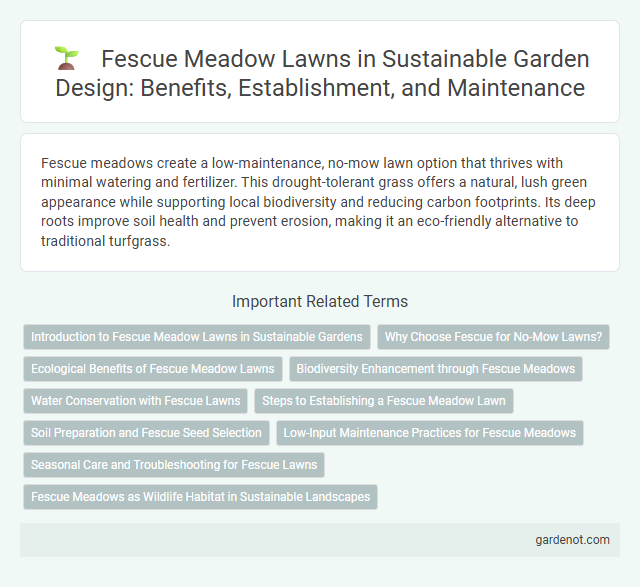Fescue meadows create a low-maintenance, no-mow lawn option that thrives with minimal watering and fertilizer. This drought-tolerant grass offers a natural, lush green appearance while supporting local biodiversity and reducing carbon footprints. Its deep roots improve soil health and prevent erosion, making it an eco-friendly alternative to traditional turfgrass.
Introduction to Fescue Meadow Lawns in Sustainable Gardens
Fescue meadow lawns are a sustainable alternative to traditional turf, offering drought tolerance and low maintenance requirements ideal for eco-friendly gardens. These lawns thrive in various soil types and climates, promoting biodiversity by providing habitat for pollinators and beneficial insects. Incorporating Fescue meadow grasses reduces water usage and chemical inputs, aligning with sustainable landscaping practices.
Why Choose Fescue for No-Mow Lawns?
Fescue is an ideal choice for no-mow lawns due to its drought tolerance and low maintenance requirements, thriving in various soil types while requiring minimal watering. Its dense growth habit naturally suppresses weeds, reducing the need for herbicides and frequent mowing. Fescue's resilience to foot traffic and adaptability to different light conditions make it perfect for sustainable, eco-friendly landscapes.
Ecological Benefits of Fescue Meadow Lawns
Fescue meadow lawns provide significant ecological benefits by promoting biodiversity, supporting native pollinators, and improving soil health through deep root systems that enhance water retention and reduce erosion. These low-maintenance lawns require less water and fewer chemical inputs compared to traditional turfgrass, reducing environmental pollution and conserving resources. Establishing a fescue meadow lawn fosters a resilient ecosystem that supports wildlife habitats while contributing to carbon sequestration and overall landscape sustainability.
Biodiversity Enhancement through Fescue Meadows
Fescue meadows significantly boost biodiversity by providing habitat for a variety of pollinators, birds, and beneficial insects, supporting complex ecosystems. Their deep-rooted grasses improve soil health and carbon sequestration, promoting environmental resilience. Establishing a no-mow fescue lawn encourages native flora to thrive, creating a sustainable habitat that enhances urban and suburban biodiversity.
Water Conservation with Fescue Lawns
Fescue lawns significantly reduce water consumption due to their deep root systems, which allow them to thrive with minimal irrigation compared to traditional grass types. This drought-tolerant grass maintains lush green coverage in drought-prone areas, promoting sustainable water conservation practices. Implementing fescue meadows in no-mow lawn designs further enhances water efficiency by minimizing soil evaporation and reducing the need for frequent watering.
Steps to Establishing a Fescue Meadow Lawn
Preparing the soil by removing existing grass and weeds, followed by aeration, creates an ideal seedbed for fescue meadow lawns. Selecting a shade-tolerant fescue seed blend and sowing at the recommended rate ensures even germination and growth. Maintaining consistent moisture through regular watering during the first few weeks and avoiding mowing until the grass reaches about 6 inches supports healthy root development.
Soil Preparation and Fescue Seed Selection
Fescue meadow establishment begins with thorough soil preparation, which involves aerating compacted soil and incorporating organic matter to improve drainage and nutrient availability. Selecting high-quality, drought-tolerant fescue seed varieties such as Tall Fescue or Fine Fescue ensures resilience in low-maintenance landscapes and supports long-term soil health. Proper seed-to-soil contact during planting enhances germination rates, promoting a dense, sustainable no-mow lawn that thrives with minimal intervention.
Low-Input Maintenance Practices for Fescue Meadows
Fescue meadows thrive with low-input maintenance practices such as minimal mowing, typically once or twice a year, to preserve native biodiversity and promote deep root growth. These meadows require reduced irrigation and limited fertilization, relying on the natural soil nutrients and rainfall patterns to sustain healthy growth. Incorporating organic mulches and periodic overseeding with native fescue varieties further supports soil health and enhances meadow resilience against weeds and pests.
Seasonal Care and Troubleshooting for Fescue Lawns
Fescue meadows thrive with seasonal care involving early spring aeration and overseeding to maintain density, while late fall fertilization enhances root development. Proper watering practices during drought periods prevent browning and stress, ensuring a healthy, resilient lawn. Common troubleshooting includes managing fungal diseases like brown patch through improved air circulation and adjusting mowing height to 3 inches to promote deeper roots and reduce weed invasion.
Fescue Meadows as Wildlife Habitat in Sustainable Landscapes
Fescue meadows provide critical wildlife habitat by supporting diverse pollinators, birds, and small mammals through dense, native grass cover and abundant seed sources. Their deep root systems improve soil health and water retention, promoting sustainable landscapes that reduce erosion and runoff. Maintaining no-mow fescue areas enhances biodiversity by creating shelter and food resources essential for local ecosystems.
Fescue meadow Infographic

 gardenot.com
gardenot.com